The Post-Mao Era
The death of Mao Zedong in 1976, the subsequent fall of the "Gang of Four," and the rise to power of Deng Xiaoping produced major changes in China that included a new cultural and economic ideology, normalization of relations with the United States, and new initiatives to reconcile two outstanding conflicts that concerned the unity of the People's Republic of China—Taiwan and the Tibet Question.
China made a number of unilateral gestures in Tibet in 1978, such as releasing a group of prisoners, announcing that Tibetans would be able to visit relatives abroad, and issuing visas to visit Tibet to a group of private Tibetans living in exile. These moves developed quickly into an "external" strategy intended to solve the Tibet Question by persuading the Dalai Lama and his followers to return to China. Informal talks took place in Hong Kong in 1978 between representatives of the Chinese government and the Dalai Lama's elder brother Gyalo Thondup (who lives in Hong Kong and speaks fluent Chinese); both sides expressed an interest in reconciling the Tibetan Question. Soon after, in 1979, Deng Xiaoping invited Gyalo Thondup to Beijing and told him that apart from the question of total independence all other issues could be discussed and all problems could be resolved. He also said that the Dalai Lama could send fact-finding delegations to Tibet in 1979–1980 to observe conditions there.[1] Beijing obviously believed that the delegations would be impressed by the progress that had been made in Tibet since 1959 and by the solidarity of the Tibetan people with the nation. China also felt that after twenty years in
exile the Dalai Lama would be eager for rapprochement with the new, more "liberal" leaders of China. The Dalai Lama responded by sending three fact-finding delegations to China, in which members of his family participated.
Ren Rong, the Han first secretary of the Communist party in Tibet, had been reporting to Beijing that political conditions in Tibet were excellent and that Tibetans were solidly behind the party and the motherland. However, when one of these delegations, including another brother of the Dalai Lama, visited Tibetan areas in Qinghai province, it received a tumultuous welcome. Beijing was embarrassed by this expression of support for the Dalai Lama and contacted Ren in Lhasa asking him what would happen if the delegation were to continue to Lhasa according to plan. Ren is said to have replied that the people of Lhasa were more ideologically developed than the simple farmers and herders of Amdo and strongly supported the ideals of the Communist party; there would be no such problems there. So strongly did the local administration in Tibet believe this that the TAR (Tibet Autonomous Region) government organized neighborhood meetings in Lhasa just before the arrival of the delegation to exhort the local Tibetan "masses" not to let their hatred of the "old society" provoke them to throw stones or spit at the Dalai Lama's delegates who were coming as guests of the Chinese government. The Lhasan masses agreed politely and then gave the delegation a welcome surpassing anything it had received in Qinghai. Thousands upon thousands of Lhasans mobbed the delegation. Many cried and prostrated, others offered ceremonial scarves, fighting to touch the Dalai Lama's brother, and a few shouted Tibetan nationalistic slogans such as "Tibet is independent" and "Han go home." Since Beijing officials accompanied the Tibetan refugee delegations, there was no way that Ren, who was known to be unsympathetic to Tibetan cultural, religious, and language reforms, could cover up this fiasco and his utter misreading of the sentiment of the Tibetan masses.
Thus, contrary to what the Chinese had expected, these visits revealed to the exiles that Chinese proclamations of socialist progress in Tibet had little substance. The living standard of the Tibetan people was poor, economic development minimal, and the destruction of religion and monasticism almost total. They also revealed that the Tibetan masses, despite twenty years of Communist propaganda, still believed strongly in the Dalai Lama and had strong feelings of Tibetan nationalism. Twenty years under China apparently had not extinguished Tibetans' belief in the sanctity of the Dalai Lama and his position as leader of the Tibetan people. It also apparently had not extinguished their feeling that Tibet should be ruled by Tibetans in accordance with Tibetan values. If the "liberation" and incorporation of Tibet into China had been aimed at winning the hearts and minds of the common people, Chinese policies and actions from 1959 to 1980 had not succeeded. The overall impact of the delegations was precisely the opposite of what Beijing had hoped: it bolstered the confidence of the exiles at a difficult time in their history.[2]
Beijing's external strategy was paralleled by a new internal strategy that sought to resolve the Tibet Question by improving economic conditions in Tibet in a manner that met the ethnic sensibilities of Tibetans. After considerable preliminary investigation, the Communist party convened a major Tibet Work Conference in Beijing in early 1980. The following statement from that conference illustrates the new attitude: "We have been established [in Tibet] for thirty years. Now the international situation is very complicated. If we do not seize the moment and immediately improve the relationship between the nationalities [Han and Tibetan] we will make a serious mistake. All the members of the Party must recognize the seriousness and we must reach a consensus."[3] Soon after, in May of 1980, Party Secretary Hu Yaobang and Vice-Premier Wan Li made an unprecedented fact-finding visit to Tibet to see conditions for themselves and determine whether the plan of the
Tibet Work Conference needed revision. They were apparently dismayed by what they saw and heard, finding it worse than they had anticipated. Hu publicly announced a liberal six-point reform program for Tibet, which included among its salient points:
(1) Full play must be given to the right of regional autonomy of minority nationalities under the unified leadership of the party Central Committee . . . .
The right to decide for oneself under unified leadership should not be abolished. It is necessary fully and independently to exercise this right. Anything that is not suited to Tibet's conditions should be rejected or modified, along with anything that is not beneficial to national unity or the development of production. The autonomous region should fully exercise its right to decide for itself under the unified leadership of the party central committee, and it should lay down laws, rules and regulations according to its special characteristics to protect the right of national autonomy and its special national interests.[4]
(2) . . . Compared with other provinces and autonomous regions of the country, it is conspicuous that in Tibet the people's living standards lag far behind. This situation means that the burden of the masses must be considerably lightened. The people in Tibet should be exempt from paying taxes and meeting purchase quotas for the next few years. . . . All kinds of exactions must be abolished. The people should not be assigned any additional work without pay. Peasants' and herdsmen's produce may be purchased at negotiated prices or bartered to supply mutual needs, and they should be exempt from meeting state purchase quotas. . . .
(3) Specific and flexible policies suited to conditions in Tibet must be carried out on the whole economic front of the region, including the agricultural, animal husbandry, financial and trade, commercial, handicraft and communication fronts, with a view of promoting Tibet's economic development more rapidly. . . . .
(5) So long as the socialist orientation is upheld, vigorous efforts must be made to revive and develop Tibetan culture, education and science . The Tibetan people have a long history and a
rich culture. The world renowned ancient Tibetan culture included fine Buddhism, graceful music and dance as well as medicine and opera, all of which are worthy of serious study and development. All ideas that ignore and weaken Tibetan culture are wrong. It is necessary to do a good job in inheriting and developing Tibetan culture.
Education has not progressed well in Tibet. Taking Tibet's special characteristics into consideration, efforts should be made to set up universities and middle and primary schools in the region. Some cultural relics and Buddhist scriptures in temples have been damaged, and conscientious effort should be made to protect, sort and study them. Cadres of Han nationality working in Tibet should learn the spoken and written Tibetan language. It should be a required subject; otherwise they will be divorced from the masses. Cherishing the people of minority nationalities is not empty talk. The Tibetan people's habits, customs, history and culture must be respected.
(6) The party's policy on minority cadre must be correctly implemented and the unity between Han and Tibetan cadres must be even more closely enhanced.... Full time cadres of Tibetan nationality should account for more than 2/3rds of all government functionaries in Xizang [Tibet], within the next 2–3 years [emphasis added].[5]
This rather remarkable public statement is said to be mild compared to the secret report and speeches Hu Yaobang made to the party cadre, one part of which is said to have equated the previous twenty years of Chinese development efforts in Tibet with throwing money into the Lhasa River.
This decision of Hu Yaobang and the Central Committee of the CCP represents a retreat from the hard-line assimilation policy of the Cultural Revolution and a return to Mao's more ethnically sensitive strategy of the 1950s. The new policy had two main components: (1) an ethnic dimension—making the Tibet Autonomous Region more Tibetan in overall character by fostering a revitalization of Tibetan culture and religion, including more extensive use of Tibetan language, and by withdrawing large numbers of Chinese cadre and replacing them
with Tibetans; and (2) an economic dimension—rapidly improving the standard of living of individual Tibetans by temporarily eliminating taxes and "below-market" quota sales, and developing infrastructure to allow Tibet to grow economically in the years ahead.
However, Beijing was no longer willing to permit a separate, non-Communist Tibetan government in Lhasa, as it had in the 1950s—Tibet would continue to be ruled by the CCP.[6] This is the "unified leadership" to which Hu Yaobang referred. While Tibetan culture, language, and ethnicity would be enhanced, and Han Chinese working in Tibet would have to learn Tibetan, Tibetans could control their region only through Tibetan Communist cadres under the auspices of the CCP. Despite Deng Xiaoping's comment that all issues other than independence could be discussed, Communist control was, in fact, simply a given. Rapprochement from the Chinese perspective meant the Dalai Lama had to return to a Tibet ruled by the Chinese Communist party.
Nevertheless, this new policy represented Beijing's attempt to redress the wrongs that had been done to Tibetans and in the process win their trust and support, albeit within the framework that Tibet was an inalienable part of China. These changes were meant to answer critics outside Tibet while at the same time demonstrating to Tibetans in Tibet that being a part of China was in their interests. Nor was this all just propaganda. Although many of the Han and Tibetan officials in Tibet strongly disagreed with this new policy, China implemented various aspects of Hu's general program in the period immediately after 1980. Individual religious practices reappeared on a massive scale throughout Tibet, monasteries reopened (with certain restrictions), and new child monks poured in to resurrect the old tradition. Signs in Tibetan were mandated on shops and official buildings, offices serving the public were instructed to use the Tibetan language in their dealings with citizens, the number of Tibetan officials was increased, plans
were made to improve education in Tibetan language, and a number of Chinese cadre left.[7] And not only were exile Tibetans welcome to return for visits, but resident Tibetans could also travel abroad to visit their relatives.
As this internal strategy emerged, Beijing also pursued its external strategy with the Dalai Lama. Informal discussions continued during the 1979–1981 period, including the following letter sent by the Dalai Lama to Deng Xiaoping on March 23, 1981:
The three fact-finding delegations have been able to find out both the positive and negative aspects of the situation in Tibet. If the Tibetan people's identity is preserved and if they are genuinely happy, there is no reason to complain. However, in reality over 90% of the Tibetans are suffering both mentally and physically, and are living in deep sorrow. These sad conditions had not been brought about by natural disasters, but by human actions. Therefore, genuine efforts must be made to solve the problem in accordance with the existing realities in a reasonable way.
In order to do this, we must improve the relationship between China and Tibet as well as between Tibetans in and outside Tibet. With truth and equality as our foundation, we must try to develop friendship between Tibetans and Chinese in the future through better understanding. The time has come to apply our common wisdom in a spirit of tolerance and broad-mindedness to achieve genuine happiness for the Tibetan people with a sense of urgency. On my part, I remain committed to contribute to the welfare of all human beings and in particular the poor and the weak to the best of my ability without making any distinction based on national boundaries. I hope you will let me know your views on the foregoing points (emphasis added).[8]
The tone of this letter was moderate and encouraging given that exiles normally demanded self-determination and independence. However, it also continued to talk of Tibet and China as separate entities. The Chinese government did not respond directly, instead commenting on the Tibet Question when the Dalai Lama's brother Gyalo Thondup secretly met
Hu Yaobang in Beijing on July 28, 1981. At this meeting Hu articulated five points on which rapprochement with the Dalai Lama should be built:
1. The Dalai Lama should be confident that China has entered a new stage of long-term political stability, steady economic growth and mutual help among all nationalities.
2. The Dalai Lama and his representatives should be frank and sincere with the central government, not beat around the bush. There should be no more quibbling over the events in 1959.
3. The central authorities sincerely welcome the Dalai Lama and his followers to come back to live. This is based on the hope that they will contribute to upholding China's unity and promoting solidarity between the Han and Tibetan nationalities, and among all nationalities, and the modernization program.
4. The Dalai Lama will enjoy the same political status and living conditions as he had before 1959. It is suggested that he not go to live in Tibet or hold local posts there. Of course, he may go back to Tibet from time to time. His followers need not worry about their jobs and living conditions. These will only be better than before.
5. When the Dalai Lama wishes to come back, he can issue a brief statement to the press. It is up to him to decide what he would like to say in the statement.[9]
This position, which at the time was not made public, reflected the Chinese government's preferred view that the Tibet Question was fundamentally a dispute between China and the Dalai Lama rather than between the government of China and the Tibetan "government-in-exile." It also conveyed the Chinese unwillingness to consider a compromise in which Tibet would enjoy a different political system from the rest of China. If the Dalai Lama returned, he would "enjoy the same political status and living conditions as he had before 1959," but not live in Tibet or hold positions there, meaning presumably that he would be given a semihonorary position such as
vice-chairman of the National People's Congress and would be taken care of financially. The political system in Tibet would therefore continue to be ruled by the Communist party. He and his followers would return as individuals, not as a new government, and they would have to "contribute to upholding China's unity and promoting solidarity between the Han and Tibetan nationalities." Although it was not part of this statement, China's quid pro quo was to permit a distinctly Tibetan ethnic/cultural identity (including Buddhism) in Tibet, and to devote resources to improve the Tibetan standard of living.
Beijing was clearly interested in persuading the Dalai Lama to return to China. From its vantage point, finalizing the right kind of rapprochement would end its problems in Tibet. The return of the Dalai Lama would relegitimize Chinese sovereignty over Tibet, end the international dialogue over the Tibet Question, and persuade the masses of Tibetans genuinely to accept their position within the People's Republic of China. The danger, of course, was that the wrong kind of rapprochement could very well create new pressures for separatism in Tibet, or worse, foment a new uprising. Consequently, it was critical to maintain political control over Tibet. Nevertheless, the Chinese were optimistic because they felt that their willingness to let Tibetan culture, religion, and language flourish, and their commitment to help Tibet develop economically, made this an attractive package. With this in mind, the Dalai Lama was invited to send a negotiating delegation to Beijing.[10] The Dalai Lama accepted, and in October 1982, three exile representatives arrived to begin what might have been a new chapter in Sino-Tibetan relations.
The problem facing the Dalai Lama and his leaders was how to respond to the Chinese at these meetings. The five-point policy outlined by Hu Yaobang had been a great disappointment to the Dalai Lama. Notwithstanding Deng's rhetoric, in essence everything excluding independence was not on the table for real negotiation. Consequently, should he and his
officials accept less than total political autonomy, and if so, how much less? Although they strongly felt that history provided convincing evidence of Tibet's independence, at least from the fall of the Qing dynasty in 1911, they also understood that Tibet was now under the physical control of a powerful China, which Tibetans could not defeat on the battlefield. The focal decision, therefore, was whether to adopt a hard-line approach that held out for real political control on the assumption that time was on their side, or to adopt a more conciliatory posture in the belief that genuine political autonomy was unattainable and that this was a unique opportunity to preserve a culturally and ethnically "Tibetan" Tibet. These very difficult choices prompted months of in-depth discussions among the top officials in Dharamsala.
The Chinese five points represented a level of compromise that was very difficult for the Dalai Lama and his leaders to even contemplate. For two decades the Tibetan government-in-exile's rhetoric had adamantly articulated Tibet's right to complete independence and had depicted the Chinese Communists as bestial, untrustworthy oppressors without a shred of humanity or honesty. Suddenly appearing willing to return to live under a Chinese Communist government, therefore, could easily undermine the legitimacy of the Dalai Lama and the exile government among the refugee community. The exile leaders also genuinely worried whether history would depict them as traitors who threw away Tibet's right to independence forever. This was a powerful emotional issue that was hard to intellectualize in an impersonal, cost-benefit, realpolitik fashion. One member of the Tibetan negotiating team commented that at first he found it hard to even smile and shake the hands of his Chinese counterparts. The Tibet Question had suddenly become more than a contest of "representations" in the world arena—the Dalai Lama and his officials held the fate of Tibetans in their hands and had to weigh carefully the potential effects on future generations of Tibet.
Complicating this was the future status of "ethnographic Tibet." The exile government was deeply committed to the re-creation of a "Greater" Tibet, which would include in one administrative unit both political and ethnographic Tibet. Such had been the goal of previous Tibetan governments (as at the Simla talks in 1913–1914) and it was deeply cherished, but it was especially important in exile because of the large numbers of Tibetan refugees from those ethnic areas. The Dalai Lama had worked hard since 1959 to meld the disparate refugees into a unified community by including Tibetans from ethnographic Tibet as equals in the exile government, and by setting as a fundamental political objective the inclusion of their areas in a future "free" Tibet. However, the goal of a Greater Tibet was not at all politically realistic. Tibet had not ruled most of these areas for a century or more, and it is difficult to see how China could have handed over large areas in Sichuan, Qinghai, Gansu, and Yunnan, many of which included Chinese and Chinese Muslim (Hui) populations that had migrated there well before the Communists came to power in 1949. However, if Dharamsala decided not to pursue a demand for a Greater Tibet, it would be breaking faith with the Eastern Tibetans in exile. Like the forsaking of independence, this issue was highly contentious and if it became known that the Dalai Lama was willing to consider it, the unity of the exile community could be permanently split.
Working in tandem with these constraints against conciliation and compromise was the view of leaders in Dharamsala that they, in a sense, held the upper hand. The visits of their fact-finding delegations had revealed that the majority of the people of Tibet were behind the Dalai Lama, so they felt they brought a powerful chip to the bargaining table—the Tibetan people's loyalty. Consequently, despite the overwhelming power of China and the absence of Western governmental support for Tibetan independence, they felt that China could not solve the Tibet Question without them. In retrospect, this
seems somewhat simplistic and naive, but to the Dalai Lama and his top officials in 1982 it was enough to tilt the balance in favor of holding fast and making no compromises. They in effect concluded that time was on their side.
In the end, therefore, there was no consensus in Dharamsala as to political and territorial concessions, and there was pressure not to create one for the negotiations in Beijing. Dharamsala consequently sent its high-level representatives to Beijing with a brief to talk only in general terms; for example, to present historical arguments about Tibet and Sino-Tibetan relations. The discussions, therefore, did not get down to substantive issues concerning the terms of the Dalai Lama's return. The Tibetans made only a single comment about their political position, stating in passing that if China was willing to offer Taiwan the "one country-two systems" option, Tibet should receive far more.
The Chinese were disappointed by the Tibetans' attitude. They had hoped the exiles would come ready to discuss specifics about their return in a friendly and forthcoming manner, and were frustrated when they persisted in talking about general issues and the "priest-patron relationship" in a way that indicated they were not ready to accept a Tibet that was under the "unified leadership" of the CCP. Like the exile leaders' overassessment of their leverage, this expectation was simplistic and naive. Beijing wanted rapprochement, but did not want to enter into a genuine give-and-take with the exiles over the issue of changes in political control of the Tibet Autonomous Region. In the end, this historic meeting produced no new movement toward solving the Tibet Question, and it raised serious questions in Beijing about the feasibility of rapprochement with the Dalai Lama.
In the aftermath of the 1982 meeting the exile leadership showed some goodwill by refraining from commenting on the meetings, but at the same time continued to attack Chinese policies and human rights violations in Tibet,[11] often going
beyond what the actual situation warranted; for example, with charges of Chinese genocide. Dharamsala still felt more comfortable waging the adversarial "representation" battle than adopting a new demeanor that sent clear signals to Beijing that the Dalai Lama was ready to work to develop new friendship and harmony.
On the Chinese side, opponents of Hu Yaobang's Tibet moderation policy interpreted the Dalai Lama's unwillingness to get down to substantive issues and his officials' continuation of attacks as a sign of their insincerity. In fact, some explicitly saw this as déjà vû—a replay of what they considered the duplicitous behavior of the Dalai Lama and his government in the 1950s. Beijing therefore moved to intensify its internal strategy by allocating increased funds for development. This policy was finalized at the Second Tibet Work Conference held in Beijing in 1984. It approved forty-two major construction projects in the Tibet Autonomous Region and extended China's "open door" policy to Tibet, despite the concerns of some leaders and experts that this would draw in more non-Tibetans and therefore exacerbate Tibetan hostility towards China and Chinese. In a sense, since Beijing could not solve the Tibet Question by inducing the Dalai Lama to return and solidify its control of Tibet, it sought to do so without him by modernizing and developing Tibet while allowing its people the freedom to express their culture and practice their religion (within the limits of China's legal system).
Nevertheless, Beijing was unwilling to cut off discussions with the Dalai Lama, and a second face-to-face meeting between Tibetan representatives and China was held in Beijing in 1984. At this meeting, the Tibetans came with a developed negotiating position. They stated that the Dalai Lama rejected the Chinese five-point proposal and made their own substantive proposal that included creation of a demilitarized Greater Tibet with complete internal political autonomy.[12] It was, of course, futile from the start. Beijing was not willing to discuss
real political autonomy for Tibet. It was looking to enhance its stability and security in Tibet, not lessen it by turning over political control of Tibet to its "enemies" in Dharamsala, let alone give them control over a Greater Tibet. In one sense, Dharamsala's leaders had misjudged both their own leverage and Beijing's desire for an agreement; in another sense, they simply could not bring themselves to contemplate accepting anything less. They were angry and frustrated by Chinese intransigence, and emotionally unable to believe that they could live under the rule of the Chinese Communist party. In this strained atmosphere a proposed visit of the Dalai Lama to China and Tibet fell by the wayside.
China continued to implement its internal policy, and by late 1985 to early 1986, many cadre and intellectuals believed that Beijing would soon initiate a second wave of reforms to fulfill the enhanced autonomous status implied by Hu Yaobang's statements. Under this system most officials would be ethnic Tibetans and the language of government would be Tibetan. In addition, the newly appointed head of the party in Tibet, Wu Jinghua, was himself a minority (from the Yi nationality) rather than a Han Chinese, sending the message that a Tibetan could be the next first secretary of the CCP. Wu Jinghua immediately began to make symbolic gestures showing his and the government's respect for Tibetan culture, for example, by wearing Tibetan dress on holidays. He also created an atmosphere of support for the development of Tibetan language and culture. Consequently, there was a feeling of possibility in the air in Lhasa, at least among Tibetan officials and intellectuals. This was still China to be sure, and political freedom of expression and assembly as we know them in the West were not permitted there or in the rest of China, but great strides had been made in permitting Tibetan culture and religion to flourish in a region that was still overwhelmingly Tibetan in demographic composition. Tibetans in exile were visiting Tibet in increasing numbers despite having to get
visas as "overseas Chinese," and most resident Tibetans who went abroad to visit relatives returned.
However, another current was gaining momentum in China as Hu Yaobang's liberal approach came under attack with regard to China itself as well as to Tibet where more leftist Tibetan and Chinese cadre were convinced that the policy of making greater concessions to Tibetans' ethnic sensitivity was flawed and dangerous. These senior officials tried to obstruct Wu Jinghua's program in Tibet and criticized his actions in Beijing through personal lines of communication. Nevertheless, the party's Tibet policy continued basically unchanged even after Hu Yaobang was forced to resign in January 1987.
Dharamsala, therefore, found itself in an awkward situation. It was clear that Beijing had no intention of allowing Tibet a different political system, let alone independence. It was also clear that Beijing was enjoying some success in the sense that its reforms had the potential to win, if not the hearts of Tibetans, at least their stomachs. Material life had improved tremendously in both Lhasa and in the countryside where communes had been disbanded. At the same time, China's economic power and international prestige were increasing, a major goal of U.S. policy in Asia being to strengthen its strategic relationship with Beijing. Thus, there was now a real danger that the exile's role in the Tibet Question would be marginalized.
Dharamsala and the Dalai Lama responded in 1986–1987 by launching a new political offensive—what we can think of as their "international campaign."[13] It sought, on the one hand, to secure new Western political and economic leverage to force Beijing to offer the concessions they wanted, and on the other hand, to give Tibetans in Tibet the hope that the Dalai Lama was on the verge of securing Western assistance to settle the Tibet Question, in essence, shifting their attention from their stomachs to their ethnic hearts.
Dharamsala's New Initiative
The U.S. government was central to this new campaign. Of all the Western democracies, the United States had provided the most support for Tibetans during the difficult times of the 1950s and 1960s. However, when the United States jettisoned its containment strategy in favor of détente with China, direct support for Tibet ended. The Tibet issue was no longer even marginally important to U.S. national interests. The exile's new campaign, therefore, sought to regain active U.S. support by working through the soft underbelly of U.S. foreign policy—Congress. The key innovation in this strategy was having the Dalai Lama for the first time carry the exile's political message to the United States and Europe, particularly at governmental forums. Previously, he had traveled and spoken only as a religious leader.[14] With the help of Western supporters and donors and sympathetic U.S. representatives and congressional aides, a campaign was launched to gain American support for the exile's cause, in essence, to redirect the significance of the Tibet Question from the arena of geopolitical national interests to the sphere of core U.S. values—to the U.S. ideological commitment to freedom and human rights. The goal was to create a momentum that would lead the United States to support Tibet because it was the just and right thing for freedom-loving Americans to do.
In 1987 several major breakthroughs occurred. In June, the House of Representatives adopted a bill that condemned human rights abuses in Tibet, instructed the president to express sympathy for Tibet, and urged China to establish a constructive dialogue with the Dalai Lama.[15] Then on September 21, the Dalai Lama made his first political speech in America before the U.S. Congressional Human Rights Caucus. It was a carefully crafted and powerful talk arguing that Tibet had been
independent when China invaded.[16] That invasion began what the Dalai Lama called China's illegal occupation of the country. Specifically, he said, "though Tibetans lost their freedom, under international law Tibet today is still an independent state under illegal occupation." The speech also raised serious human rights charges, referring twice to a Chinese-inflicted "holocaust" on the Tibetan people.
The Dalai Lama made a five-point proposal for solving the Tibet Question that called for the following:
1. Transforming Tibet into a "Zone of Peace"—this would include ethnographic Tibet and would require the withdrawal of all Chinese troops and military installations.
2. Reversing the population transfer policy which he said threatened the very existence of the Tibetans as a people.
3. Respecting the Tibetan people's fundamental human rights and democratic freedoms—it asserted that "deprived of all basic democratic rights and freedoms, [Tibetans] exist under a colonial administration in which all real power is wielded by Chinese officials of the Communist Party and the army."
4. Restoring and protecting Tibet's natural environment and abandoning China's use of Tibet for the production of nuclear weapons and dumping of nuclear waste.
5. Beginning earnest negotiations on the future status of Tibet and of relations between the Tibetan and Chinese peoples.
This speech was well received in the United States, and three weeks later, on October 6, the Senate passed its version of the earlier House bill. Ultimately, on December 22, 1987,
President Reagan signed the (1988–1989) Foreign Relations Authorization Act into law, including a nonbinding sense-of-the-Congress amendment that made the following points:
(i) The United States should express sympathy for those Tibetans who have suffered and died as a result of fighting, persecution, or famine over the past four decades.
(ii) The United States should make the treatment of the Tibetan people an important factor in its conduct of relations with the People's Republic of China.
(iii) The Government of the People's Republic of China should respect internationally recognized human rights and end human rights violations against Tibetans.
(iv) The United States should urge the Government of the People's Republic of China to actively reciprocate the Dalai Lama's efforts to establish a constructive dialogue on the future of Tibet.
(viii) The United States should urge the People's Republic of China to release all political prisoners in Tibet.[17]
It also added a proviso that in regard to the sale of defense articles, the United States should take into consideration "the extent to which the Government of the People's Republic of China is acting in good faith and in a timely manner to resolve human rights issues in Tibet," and it authorized no less than fifteen scholarships to enable Tibetans to attend college in the United States.[18]
Although this policy was far weaker than the now-defunct position stated by Christian Herter in 1960, and it was only a "sense of Congress," it was seen in Dharamsala as a major victory—as the start of a Congress-driven move to create a new U.S. foreign policy that would proactively seek settlement of the Tibet Question in a manner favorable to the Dalai Lama. From out of nowhere, therefore, the United States was again actively involved in the Tibet Question, albeit through Congress rather than the executive branch or the State Department.
The First Riot—October 1, 1987
These activities of the Dalai Lama in the United States were widely known and eagerly followed in Lhasa.[19] Tibetans regularly listened to the Voice of America and BBC Chinese language broadcasts, and the Chinese government also broadcast attacks on the Dalai Lama's visit in the local media. On September 27, less than a week after the Dalai Lama's first speech in Washington, nationalistic monks from Drepung monastery in Lhasa staged a political demonstration in support of Tibetan independence and the Dalai Lama's initiative. They began by walking around the Inner Circle Road (bagor ) that is both a main circumambulation route (going around the holy Lhasa Cathedral) and the main Tibetan market area. When no police appeared after several circuits, they marched down a main road to the offices of the Tibetan government. There they were arrested.
Four days later, on the morning of October 1, another group of twenty to thirty monks demonstrated in Lhasa to show their support for the Dalai Lama and the previous demonstrators, and to demand the latter's release from jail. Police quickly took them into custody and started beating them. A crowd of Tibetans who had gathered outside the police headquarters demanded these monks be released, and before long, this popular protest escalated into a full-scale riot. In the end, the police station and a number of vehicles and shops were burnt down, and anywhere from six to twenty Tibetans were killed when police (some of whom were ethnic Tibetans) fired at the crowds.
Beijing was shocked by the riot and the anti-Chinese anger it expressed. Clandestine nationalistic incidents had occurred for years in Lhasa but these were small, isolated activities that were easy to deal with. Now Beijing had to face the reality that thousands upon thousands of average Tibetans were angry
enough to face death and prison by participating in a massive riot against the government and Chinese rule. This riot was particularly galling to Beijing because it coincided with the attacks of the Dalai Lama and U.S. congressional representatives, apparently proving to the world that statements about the horrendous conditions in Tibet were true despite the fact that the Chinese felt they were pursuing a moderate, conciliatory policy.
The months after the riots in Lhasa saw more demonstrations by monks and nuns and a steady stream of antigovernment posters. Nevertheless, the police were able to arrest the demonstrators quickly without provoking a riot. A cat-and-mouse game developed in which nationalistic monks launched demonstrations and the government tried to arrest them in a manner that would prevent another riot, for it was clearly the riot that had caught world attention, not simply the small demonstrations.
As 1987 drew to a close, attention in Lhasa turned to the coming Tibetan New Year in February 1988 and the accompanying Great Prayer Festival when almost 2,000 monks would come to Lhasa's Central Cathedral for several weeks of joint prayers.[20] The question of the day became whether the Prayer Festival would go on as planned, and if so, whether the monks would try to use it to launch a major demonstration. The risk of another riot was considerable since there would be thousands upon thousands of religious Tibetans in Lhasa at this time to witness the festival.
Many senior cadre in Tibet felt that the 1987 riot vindicated their contention that the conciliatory "ethnic" approach was dangerous and could result in the CCP losing power in Tibet. Several ad hoc secret meetings held in Lhasa and Chengdu (Sichuan) issued reports critical of the liberal policy and informally forwarded them to Beijing, where the new head of the party, Zhao Ziyang, convened a meeting of the larger Politburo to discuss Tibet. In November, its members decided that part
of the present problem in Tibet was that Beijing's Tibet policy had not been properly carried out. However, at the same time, it also concluded that the policy had been too liberal. This marked the beginning of Beijing's retreat from its earlier approach.
Soon after the Politburo decision, the Lhasa daily newspaper announced the new line in a front-page article that laid part of the blame for the October riot on the excessive and incorrect application of "ultraleftist ideology" by local cadre. Until then it had totally blamed outside agitation for the demonstrations and riot. Now it admitted that its own officials were part of the problem. This was a calculated attempt to gain favor with the Tibetans in Lhasa by being realistic and forthright, even though the admission certainly angered many senior officials in Tibet.
At this time Beijing also made a decision that, in retrospect, was ill conceived. On the defensive internationally, the Chinese leadership apparently felt it was important to show the world that its liberal Tibetan religious policy was working, so it pushed ahead with the Great Prayer Festival. Wu Jinghua, the head of the TAR, announced that just as he had come to the Prayer Festival in Tibetan dress in the past, he would do so again this coming year to publicly show his respect for Tibetans' strong feelings about their religion and culture. He also announced that his three main priorities for Tibet were religion, national culture, and united front activities, in essence indicating that the core of his program would continue to be improved relations with Tibetans by paying attention to their ethnic sensitivities rather than to economic development per se.
The main event in this attempted reconciliation was a visit to Lhasa in early 1988 by the late Panchen Lama, Tibet's number-two incarnation. He was sent to Tibet with authorization to make concessions that would calm the monks and ensure the success of the Great Prayer Festival. The plan was to offer the monks substantial financial reparations and looser restrictions
if they attended the Prayer Festival and in the future concentrated on religion, not politics. In response to demands that all monks be released before the festival, the Tibetan government on January 26, 1988, released fifty-nine monks as a gesture of goodwill, leaving only about fifteen monks in custody.[21] On the following day, at a big meeting at Drepung monastery, the Panchen Lama told the assembled monks that the government was willing to give 2 million yuan ($500,000) in reparations to the three Lhasa monasteries (Drepung, Sera, and Ganden).
The Panchen Lama's attempt to defuse the situation was unsuccessful. The anger of most of the monks toward Chinese policies in Tibet was too great to be assuaged by money. They felt that the Chinese were now trying to use the Prayer Festival as propaganda against the Dalai Lama's initiative, and they felt that time was on their side since the Dalai Lama was now succeeding in gaining U.S. support. Given this atmosphere, many of the older monks advised the government not to hold the Prayer Festival in Lhasa since they could not guarantee what the younger monks would do. They strongly recommended that the 1988 Prayer Festival be conducted at their own monasteries rather than in the Central Cathedral in Lhasa.
But the government dug in its heels and insisted the Great Prayer Festival had to go on. Foreign journalists had been invited, so the government cajoled, threatened, and pleaded with the monks to appear. Although many monks boycotted the event, most came and all went well until March 5, 1988, the last day. As the monks completed the procession of carrying the statue of Chamba (Maitreya), a monk shouted at the ranking officials seated at the ceremony to release a monk who remained in jail. When a Tibetan official told him to shut up, he and other monks immediately responded that Tibet is an independent country. Just when everyone thought that the ceremony had passed without a disaster, the situation went out of control and the latent anger exploded into the second terrible
riot in Lhasa. Arrests and a clampdown in Tibet followed that further drew the mass of people to the side of the radical nationalists.
Etiology of the Riots
It is instructive to examine why the series of riots occurred if China was pursuing what it considered a moderate, ethnically sensitive reform policy.
The Chinese claim that the demonstration was in part inspired by Dharamsala. It is not clear whether Dharamsala (or other exile elements) actually asked one or more of the Drepung monastery monks to organize a demonstration, but it is clear that the monks' demonstration was meant to counter Chinese criticisms broadcast in the Lhasa media and demonstrate support for the Dalai Lama's new initiative in the United States. To this day the monks are proud that they risked (and are risking) their lives to support the Dalai Lama's efforts in the West on Tibet's behalf.[22]
One factor underlying the Tibetans' attitude was that they interpreted U.S. events in the framework of the Chinese system of government. In China, delegates at the People's Congress rubber-stamp what has already been decided by the party, so it was natural for Tibetans in Lhasa to believe that the support shown by members of the U.S. Congress reflected support by the U.S. government for the Dalai Lama and Tibetan independence. Many average Tibetans in Lhasa, therefore, believed that the Dalai Lama's speech to the Human Rights Caucus of Congress was a turning point in Tibetan history, and that the United States, in their eyes the world's greatest military power, would soon force China to "free" Tibet. Events in the West are well-known through shortwave radio broadcasts and play an important role in determining the attitude of Tibetans, particularly Lhasans.
In any case, it is clear that those first monk demonstrators never dreamed their civil disobedience in support of the Dalai Lama would provoke a bloody anti-Chinese riot. The real cause of the massive riot—as distinct from the small political demonstration—is complex. Despite the Chinese reforms, a volatile residue of bitterness and resentment against the government (which in Tibetans' minds was synonymous with the Han Chinese) remained.
Tibetans were still very angry about the loss of their country and the personal and collective (ethnic) suffering they had experienced since 1959 under direct Chinese rule. Like some minority groups in the United States, they view past oppression as part of present reality and direct their resentment at today's Han Chinese. The condescending attitudes of many Han in Tibet tended to reinforce these ill feelings.
Moreover, Chinese insistence on a crash program of economic development in Tibet created new problems, the most important of which was the large influx of Chinese and Muslims (Han and Hui) into Tibet since 1984. Ironically, this process does not appear to have started as a deliberate Chinese scheme to "swamp" Tibet with Han "colonists," as is often charged, but rather as a result of the government's desire to develop Tibet quickly. The large funds disbursed for development projects created a substantial economic ripple effect, attracting thousands of Han construction workers whose presence in turn created a demand for scores of new Chinese restaurants, shops, and services. This, however, was understood to be problematic, and the party secretary in Tibet at one time in 1984 actually stopped Han and Hui coming in from Qinghai. But the larger need in Tibet for carpenters, masons, and other skilled workers gradually overwhelmed these attempts, and the success of these Han tradesmen and craftsmen sent a message to the surrounding provinces that there was profit to be made in Tibet, drawing in even larger numbers of new Han and Hui annually. Today even Han beggars ply their
trade in Lhasa. Most Tibetans in Lhasa resented the increasing control of the Han in their local economy, taking jobs away from them and Sinicizing their beloved city. They wanted economic improvement but not at the expense of transforming the ethnic and demographic character of Lhasa and Tibet.
The accelerated development program for Tibet therefore exacerbated existing local feelings of anger and bitterness over past harms done to Tibet since "liberation" in 1951, and worked to undermine the positive impact of the new reforms on Tibetans' attitudes and feelings. Moreover, it focused Tibetans' attention precisely on the volatile ethnic or national issue—there were too many Han in Tibet and they were getting too many benefits. This situation in turn fueled the Tibetans' feeling of powerlessness and abuse at the hands of the dominant Han.
Another important problem was Beijing's reluctance to permit as full an expression of cultural and religious freedom as Tibetans wanted. Although a substantial revival of Buddhism had occurred since Deng's rise to power, and many once-great monasteries like Drepung were again functioning as genuine religious centers, a number of restrictions in areas such as the total number of monks remained. These limits angered the monks and many laymen and highlighted the fact that Tibetans are still beholden to an alien, Chinese value system for permission to practice their own religion and culture in their own homeland. From Beijing's perspective, however, these restrictions made sense since the monasteries were hotbeds of nationalism and proindependence activists. Allowing them to grow in size and wealth would strengthen the very people who were most dedicated to challenging China's position in Tibet, but restricting them made it easy for Tibetans in Lhasa to see the glass as half empty rather than half full.
Finally, one cannot underestimate the strong historical and nationalistic sense of Tibet as an exclusively Tibetan homeland. Because there were no Han Chinese in Tibet in 1950, all adult Tibetans vividly remember a completely Tibetan Tibet. They
felt that the Chinese had taken their country and were transforming it into just another part of China. They believed (and believe) that Tibet should be run by Tibetans, use Tibetan language, and follow laws that are in accordance with the deeply felt values and beliefs at the heart of Tibetan culture. For most Tibetans, the new reforms had made progress toward that end, but it was not enough for individuals to be allowed to turn prayer wheels and burn butter lamps if Tibet were not a homogeneous ethnic entity. The influx of Han workers was clearly a serious a step in the wrong direction, and was not in keeping with the spirit of Hu Yaobang's policy.
In the fall of 1987, on the eve of the first riot, Lhasa's Tibetans therefore had ambivalent attitudes and feelings. Pent-up anger, resentment, and frustration competed with the realization that cultural, linguistic, and economic conditions had improved dramatically. And critically, the new successes of the Dalai Lama in the United States offered what seemed a realistic alternative to Chinese domination—it gave them new hope that with the work of the Dalai Lama and the power of the United States, independence was just around the corner.
In this atmosphere the quintessential symbol of Tibetan civilization and greatness—the monks—provided the catalyst needed to ignite the anger. The 1987 and 1988 riots were thus primarily spontaneous outbursts of pent-up resentment and anger. Rather than a rejection of the reform policy since 1980, they were unplanned responses to a situation that Tibetans felt symbolized the loss of their nationhood and the denigration of their culture since 1959 by a dominant and alien group. They share many similarities with the terrible racial riots the United States experienced in Watts and other inner-city neighborhoods, or the anger of Native Americans that exploded at Wounded Knee. When Tibetans saw the police beating up the unarmed monks, they responded with their ethnic hearts. They responded not to poor material conditions, but to past injustices and to present domination by an alien majority.
Building one more stadium, or road, or factory, or apartment building could no more eliminate that problem in Lhasa than it could in the U.S. ghettos.
Beijing's Hard-line Strategy
New congressional support in the United States, coupled with the demonstrations and riots in Tibet, led the exiles to conclude that they were beginning to amass the critical leverage needed to pressure Beijing to yield to their demands for political autonomy.
In April of 1988, the Chinese announced that if the Dalai Lama publicly gave up the goal of independence, he could live in Tibet (rather than Beijing). Two months later, on June 15, 1988, the Dalai Lama responded to this announcement in an address to the European Parliament at Strasbourg. This marked the first public statement of his conditions for returning to Tibet. Its main points were:
The whole of Tibet [political and ethnographic] . . . should become a self-governing democratic political entity founded on law by agreement of the people for the common good and protection of themselves and their environment, in association with the People's Republic of China.
The Government of the People's Republic of China could remain responsible for Tibet's foreign policy. The Government of Tibet should, however, develop and maintain relations through its own Foreign Affairs Bureau, in the fields of religion, commerce, education, culture, tourism, science, sports, and other nonpolitical activities. Tibet should join international organizations concerned with such activities.
The Government of Tibet should be founded on a constitution of basic law. The basic law should provide for a democratic system of government . . . This means that the Government of Tibet will have the right to decide on all affairs relating to Tibet and Tibetans.
As individual freedom is the real source and potential of any society's development, the Government of Tibet would seek to
ensure this freedom by adherence to the Universal Declaration of Human Rights, including the rights to speech, assembly, and religion. Because religion constitutes the source of Tibet's national identity, and spiritual values lie at the very heart of Tibet's rich culture, it would be the special duty of the Government of Tibet to safeguard and develop its practice.
The Government should be comprised of a popularly elected Chief Executive, a bi-cameral legislative branch, and an independent judicial system. Its seat should be Lhasa.
The social and economic system of Tibet should be determined in accordance with the wishes of the Tibetan people, bearing in mind especially the need to raise the standard of living of the entire population.
. . . A regional peace conference should be called to ensure Tibet becomes a genuine sanctuary of peace through demilitarization. Until such a peace conference can be convened and demilitarized and neutralization achieved, China could have the right to maintain a restricted number of military installations in Tibet. These must be solely for defense purposes.[23]
The Dalai Lama indicated he was ready to talk with the Chinese about this proposal and announced the membership of his negotiating team, including a Dutch national as its legal advisor.
The Strasbourg proposal did not seek complete independence, but it also did not accept the limited autonomy of the Chinese political system. Rather it called for Tibet to have a new status as a kind of autonomous dominion much as it had been under the Qing dynasty. The Dalai Lama would accept being part of China, but China would have little authority over affairs in Tibet. Since this proposal had in essence been presented to Beijing at the secret 1984 talks, it did not represent anything new to the Chinese. Nevertheless, the speech was important because it was the first time the Dalai Lama openly told his people (and the world) that independence was not a realistic goal and that he was willing to accept Tibet as part of China if it could be totally autonomous. It was in this sense a
courageous initiative, and it created a stir in exile politics, where it was criticized by many as a sellout.[24]
The proposal was also an effective political tactic. If, as the exile leaders hoped, their victories had persuaded Beijing to view this level of political autonomy more favorably now than in 1984, serious negotiations could have ensued. At the same time, it placed Beijing in a difficult situation since Deng Xiaoping and other top leaders had repeatedly said that with the exception of independence they would discuss anything. Now the Dalai Lama had given them just such an opportunity before the eyes of the world. Consequently, rejection would make Beijing seem unreasonable and simultaneously enhance the Dalai Lama's international reputation as a statesman willing to compromise in order to attain a lasting peace.
The Strasbourg address initially threw Beijing into confusion. The leadership had not changed its basic view of what compromise solution it was willing to accept, but there was support for at least giving the impression of willingness to discuss the Strasbourg proposal since it did not demand independence per se. Ultimately, after some initial signs of interest, the more hard-line view predominated and Strasbourg was rejected as an indirect form of independence. In retrospect, given the internal situation in China, it is difficult to see how Beijing could have permitted Tibetans to have the freedoms associated with Western democracies and not offer the rest of China the same options, let alone how it could allow the creation of a Greater Tibet. It was also unnecessarily provocative for Dharamsala to include a Western advisor on the negotiating team given China's feelings about outside interference. Talks, therefore, did not occur and six months later, in December 1988, monks demonstrating in commemoration of International Human Rights Day precipitated a third bloody riot in Lhasa.
In the midst of this deteriorating situation the unexpected death on January 28, 1989, of Tibet's second highest incarnation—the Panchen Lama—produced a surprising secret initiative from Beijing. Hoping to cut through the impasse with the Dalai Lama, China had its Buddhist Association invite the Dalai Lama to Beijing to participate in the memorial ceremony for the Panchen Lama, letting it be known that this would be a good time for him to discuss the political situation informally with top Chinese officials.[25] The Dalai Lama had suddenly been offered an exceptional opportunity to visit China without having to sort out complicated political protocol issues. The rationale behind this approach was the belief in China that the Dalai Lama was more moderate than his advisors and direct discussion might possibly break the deadlock.
The Dalai Lama and his officials, however, were reluctant to accept the invitation. The Chinese had indicated that the Dalai Lama would not be allowed to visit Tibet, so the exile leaders were concerned that Tibetans in Lhasa might feel abandoned if he went to China but not Tibet. They also feared that China might humiliate the Dalai Lama by ignoring him or treating him as a minor figure. Additionally, it is also likely that hard-line officials in Dharamsala feared that in face-to-face talks with top Chinese leaders the Dalai Lama might accept a less favorable compromise than they wanted. So, with events apparently going well from their perspective, the exile leadership persuaded the Dalai Lama to take the safe course and decline the invitation, telling the Chinese Buddhist Association that they had done all the appropriate rites in Dharamsala.[26] Many look back at this as one of the most important lost opportunities in the post-1978 era.
Meanwhile, the situation in Tibet deteriorated further in 1989. Tibetans in Lhasa continued to mount small nationalistic demonstrations, one of which turned into the fourth Lhasa riot on March 5, 1989. At this juncture, Beijing accepted the fact that Tibet was veering out of control and initiated strong measures
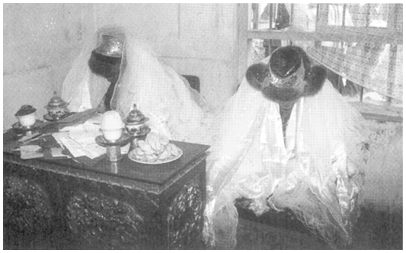
1. Despite being educated government office workers, this couple,
as is common in Tibet, opted for a traditional Tibetan wedding.
Hundreds of invited guests filed by the groom (left) and bride
(right in this tiny room, draping a traditional Tibetan ceremonial
scarf (katak ) on each of their necks and leaving a cash present in
a Tibetan (hand-folded) envelope on the table in front of them.
The guests then retired to a large rented hall where they were
feted for each of the next three days—drinking, eating, and
playing games like mah-jongg .
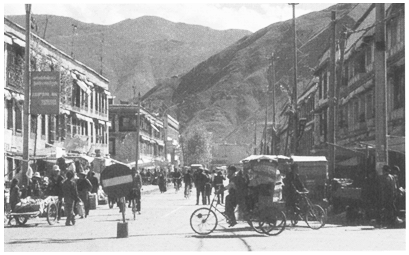
2. Ringed by the bare hills of the Lhasa Valley, the inner city—the
old section of town where most of the indigenous Lhasans live—is
a jumble of streets shared by cars, bikes, rickshaws, and pedestrians.
Most of the traditional houses lining the street have been replaced
with concrete buildings, but generally—as seen in this photograph—in
a similar style. The ubiquitous prayer flags fluttering on the roofs
signal Tibetans' strong commitment to their traditional religion
and culture.
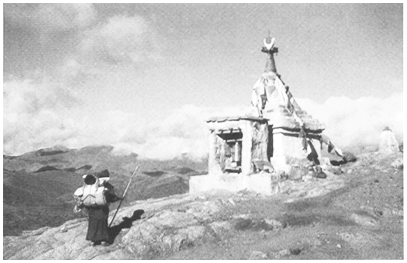
3. For a thousand years, Tibetan monks and laypersons have gone on
pilgrimages to holy sites throughout Tibet. Many walk for months
to remote places like Mt. Kailash, the famous center of the Buddhist
universe located in far western Tibet where this lone monk was headed.
Carrying his belongings on a traditional bentwood rucksack frame and
clutching the classic wooden pilgrim's staff in his hand, he had already
traveled five months (over seven hundred miles from his home monastery
in Sichuan province) to reach this stupa two hundred miles west of Lhasa.
And he still had another three hundred fifty miles (two months) to walk
to reach his goal.
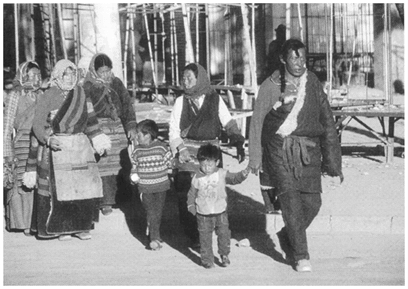
4.–5. Above—A family of nomads from northern Tibet on pilgrimage
in Lhasa to see the famous Jo Rimpoche statute in Lhasa's cathedral.
Dressed in their everyday nomad sheepskin clothes, this was their first
visit to Lhasa. Below—By contrast, these two Lhasa Tibetans are chic
and modern and would not have seemed out of place in Beijing or Cleveland,
Beijing's hope is that this generation (and their children) will become
modern Tibetans, comfortable with being part of China.
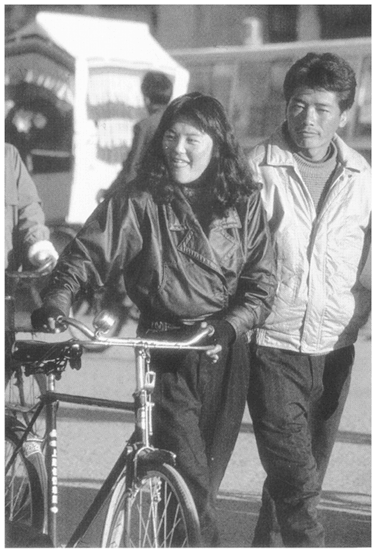
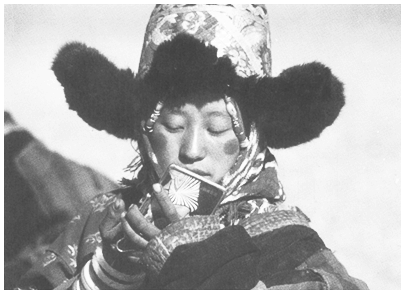
6. A nomad girl living at an altitude of 16,500 feet on Tibet's
"Chantang" (northern plateau), carefully examines her "make-up" in
a mirror manufactured in eastern China. The rouge on her cheeks is
actually from a seal-stamping inkpad.
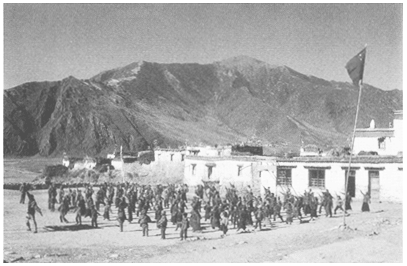
7. Students at a village primary school in Drigung county start the
day with a round of calisthenics. For many families in this area, school
represents a hope that some of their children will be able to find work
off the family farm.
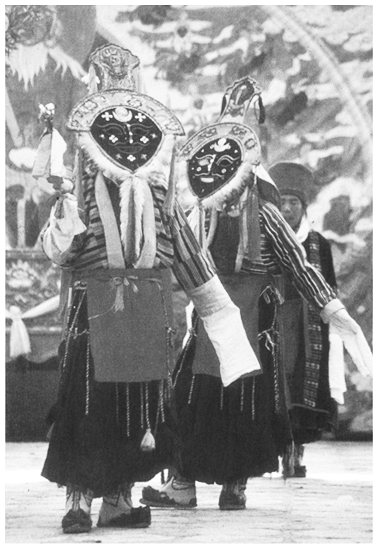
8. One of the most popular holidy periods in Lhasa is Shodün , the
festival of the traditional Tibetan opera that is performed in late August.
The plays have Buddhist themes and performed by masked dancer-singers.
Thousands of Lhasans attend the performances in Drepung monastery,
Norbulingka, and other locations around Lhasa. Here the ngomba , or
"hunters," were performing their dance.
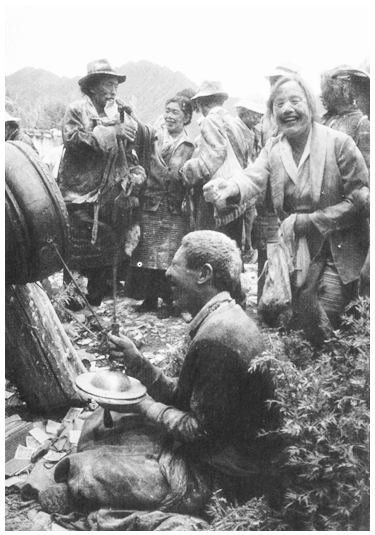
9. The birthday of the fourteenth Dalai Lama (July 6) is a holiday
in Lhasa celebrated by thousands of Tibetans going to a park in the
southeastern part of the city, offering propitiations in the form
of prayers, incense, and barley-flour, and having picnics. In recent years a
new custom has emerged in which everyone attending throws roasted
barley-flour at one another. After an hour of this, all the participants
are covered from head to foot with white flour.
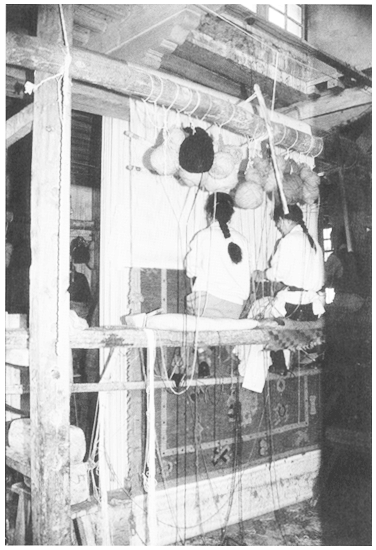
10. One area of economic development where Tibetans have been
able to excel is the production and export of hand-knotted carpets.
Tibetans have adapted the designs and production techniques of their
traditional carpet making to produce internationally competitive rugs. Here
two young women employed by a large co-op carpet factory in Lhasa
work on a huge loom weaving a livingroom-size rug.
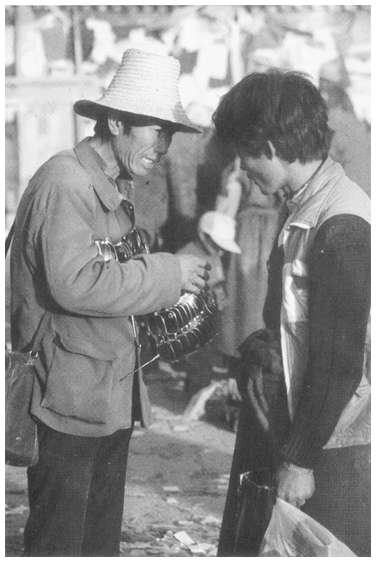
11. Many Chinese itinerant peddlers like this man walk the streets
of Lhasa selling sunglasses to local Tibetans like this boy.
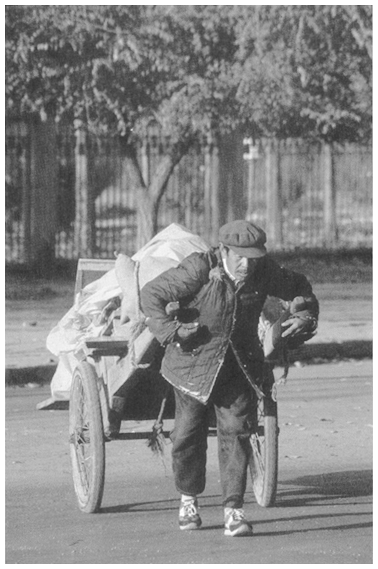
12. Chinese involvement in Tibet's economy now includes beggars
and manual laborers like this Han Chinese man.
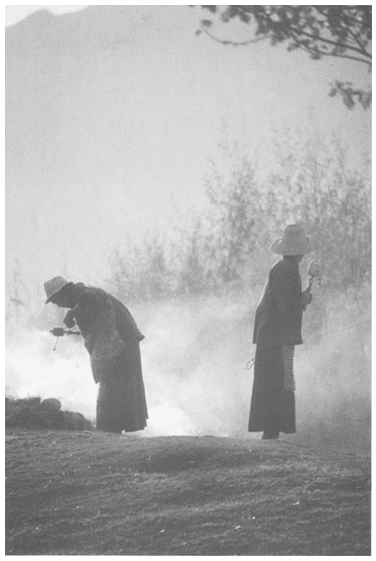
13. Tibetans in Lhasa throw some incense into a fire a long the
five-mile circumambulation road that circuits the city. Each of the
women turns a hand-held prayer wheel throughout
the circumambulation.
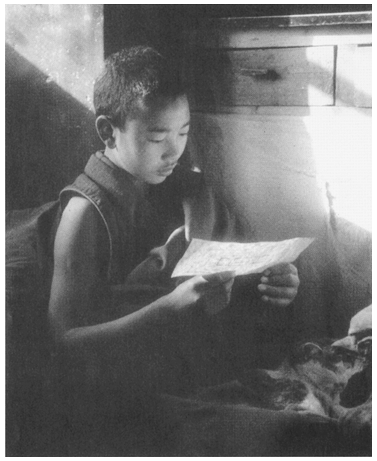
14. After being totally eliminated during the Cultural Revolution,
monastic life has been revived throughout Tibet, although the largest
monastery in Lhasa, Drepung, now holds only seven hundred where
it held ten thousand in 1959. Here a young monk sits in his apartment
in Drepung monastery memorizing a religious text.
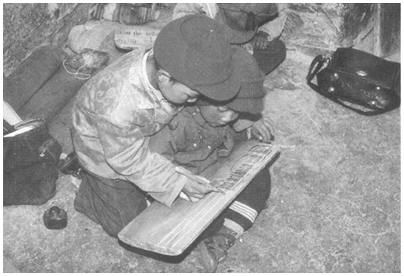
15. Education has become increasingly important in Lhasa, and
private pre-primary schools have become popular with many parents.
This school was founded and operated by a former monk official in the
traditional government and had several score of students learning how
to read and write in Tibetan. Here an older student helps teach a new
preschooler how to write in Tibetan using the old custom of holding the
student's hand and moving it through the motions of forming the letter.
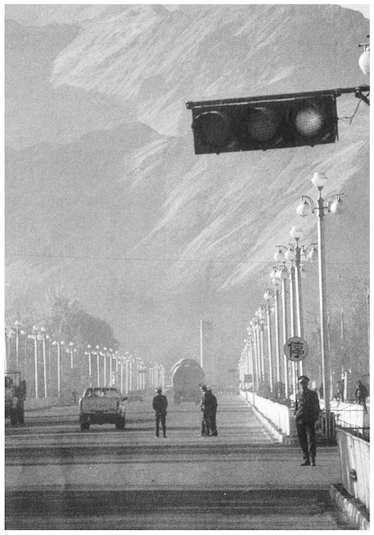
16. Police and army in Lhasa generally keep a low profile until there
is a political disturbance. Here some police monitor a major road in the
west of Lhasa. The monument in the background honors the Chinese
workers who built the main road from China to Lhasa in the 1950s.
In 1996 it was damaged by a bomb placed by Tibetan nationalists.
to quell the unrest, taking the drastic step of declaring martial law in Tibet.
The year 1989 brought another dramatic setback for Beijing when the Dalai Lama was awarded the Nobel Peace Prize. Tibetans everywhere considered this a major victory—an indirect but powerful statement that their cause was just and valid, and a sign that the world was lining up behind the Dalai Lama in his fight with China. Finally, 1989 also brought the Tiananmen debacle. Although this event had no direct impact on the situation in Tibet because Tibetans had little interest in or sympathy for what they considered a "Han" affair, it fostered a more hard-line political policy in China that made it easier to take stern measures in Tibet.
By the end of 1989, therefore, Beijing's internal and external strategies for Tibet were clearly in shambles. Unless China was willing to relinquish direct political control in Tibet and accept a Strasbourg-like dominion status, the exiles appeared bent on continuing their international campaign, thus encouraging more internal demonstrations and new international accusations. Momentum appeared to have shifted to the Dalai Lama, whose international initiative had successfully turned the tables on China, placing Beijing on the defensive both in the world arena and within Tibet.
Beijing reacted predictably to the threat this shift in momentum posed by moving to a more hard-line, integrationist policy. In Beijing it was hard for moderates to refute the historical parallel between Mao's gradualist Tibet policy (supporting the Dalai Lama while postponing reforms), precipitating the 1959 rebellion, and Hu Yaobang's policy, leading to the 1987–1989 riots. Many officials felt strongly that if China did not stop "coddling" the reactionary and superstitious Tibetans, matters could get completely out of hand. A comment made by Qiao Shi, China's security chief (now head of the National People's Congress) during an investigative trip to Lhasa reveals the anger and frustration felt in Beijing. At a Tibetan
Political Consultative Conference meeting in Lhasa, former Tibetan government and religious leaders criticized current policy on religion, language, and economics. Qiao Shi responded angrily, lashing out at the former elite in "class struggle" language they hadn't heard since the rise of Deng Xiaoping in 1978. He reminded them that the government had made monetary restitutions for its past wrongs and gave them a new high status; then he sarcastically asked whether they wanted still more—"What do you want us to do?" he said, "Give you back your servants so that you can live like the old society?"
The move away from the moderate Hu Yaobang approach was formalized in the winter of 1989 at a meeting of the Politburo. The general feeling among the leadership was that the measures Beijing had taken to liberalize conditions within Tibet had neither produced greater appreciation from the Lhasan masses nor convinced them that their interests could best be met as part of China. To the contrary, they had increased nationalistic aspirations and had yielded disturbances and riots that actually weakened China's position in Tibet. This failure prompted Beijing to focus on a strategy to enhance their security in Tibet in ways that did not depend on having to win over the large segment of Tibet's current adult generation who were considered hopelessly reactionary.
The new policy operated under the assumption that it was unrealistic to expect the Dalai Lama to play a constructive role in Tibet. Beijing would try to solve the Tibetan problem without him. More concretely, the leadership of the party in Tibet was to be strengthened by sending better educated personnel (non-Tibetans) who would be able to modernize the area and people more effectively. Similarly, greater emphasis was placed on educating young Tibetan cadre and reinvigorating the party structure at all levels—from the top down to the village level. And, of course, security was vastly improved by increasing the number of plainclothes officers and police substations in
volatile areas and enhancing surveillance equipment. As a result of these and other measures, new demonstrations were quickly brought under control and prevented from escalating into riots. Indeed, during the seven years since martial law was lifted in 1990, there have been no new riots, despite frequent demonstrations. This control was accomplished, moreover, without restricting the day-to-day life of the inhabitants of Lhasa—as long as Lhasans did not engage in political dissidence, they were free to go where they wished, meet with friends, invite monks for religious services, have parties, and so forth. This success has given Beijing's leaders confidence that their security forces can handle whatever tactics Tibetans dissidents (or exiles) employ.
The cornerstone of the central government's new policy was (and is) economic growth and modernization—accelerating economic development in Tibet by providing large subsidies for development projects aimed at building infrastructure and productive capacity. This strategy seeks to modernize Tibet's economy and people, increasing their income and reducing their isolation by inextricably linking Tibet's economy with the rest of China. To do this effectively, Beijing has decided that Tibet must be rapidly developed. The Third (National) Tibet Work Conference held in Beijing in July 1994, for example, decreed that Tibet "urgently needs to develop faster" and set out an economic program that called for 10 percent economic growth per annum and a doubling of Tibet's 1993 gross domestic product by the year 2000. Beijing also has committed 2.38 billion yuan (about 270 million dollars) for sixty-two infrastructure construction projects approved at the 1994 meeting.[27]
In some ways, the new economic strategy is doing what Beijing hoped. A number of Tibetans have clearly benefited economically, and others are now turning their attention from politics to new economic opportunities. However, the policy also appears to be creating a serious backlash.
A key component of the "economic integration" approach is the freedom of non-Tibetans (Han and Hui) to do business in Tibet. Tens of thousands of Han and Hui have been drawn to Tibet to participate in construction projects and to open businesses. These numbers are continuing to increase as Beijing escalates its economic funds and subsidies there. These non-Tibetans are part of a phenomenon common throughout China called "floating population"—that is to say, they are permanent residents in one area (usually a village) but live and work temporarily in another, usually a city. They do not have "citizen" rights in the place where they work, so they are not "colonists" in the usual sense, but nonetheless they live there for all or part of any given year.[28] Begun in earnest when China extended its "open door" policy to Tibet in 1984–1985, this influx has accelerated tremendously as a result of the rapid economic development. There are no accurate data on the numbers of such people in Tibet (TAR), but they have dramatically changed the demographic composition and atmosphere of Lhasa and are beginning to expand into smaller "urban" areas such as county seats (xian ). The number of these non-Tibetans is unprecedented in Tibetan history and has turned Lhasa, the political heart of Tibet, into a city where non-Tibetan residents appear to equal or exceed the number of actual Tibetans.
Non-Tibetans now control a large segment of all levels of the local economy—from street corner bicycle repairmen to computer store owners to large firms trading with the rest of China. Numerous Tibetans in Lhasa have complained about this flood, arguing that it should be stopped or severely limited because Tibet is a minority "autonomous region" where Tibetans, not outsiders, should be the primary beneficiaries of the new growth in the market economy. Tibetans believe they cannot compete economically with the more skilled and industrious Han and Hui; without government intervention to ensure the welfare of the citizens of the autonomous region, they expect to become increasingly marginalized both eco-
nomically and demographically.[29] These voices argue that just as Beijing has erected powerful barriers to keep more advanced foreigners from taking control of China's new industrial ventures, Tibet should adopt regulations that protect Tibetans from the more advantaged and better financed Chinese.
Beijing rejects this argument, insisting that rapid development takes precedence over all else. It has refused to stop or restrict the flow of non-Tibetan workers or to pass specific economic protection legislation for minority regions. Deng Xiaoping himself strongly supported this position. In 1987, for example, he said: "Tibet is sparsely populated. The two million Tibetans are not enough to handle the task of developing such a huge region. There is no harm in sending Han into Tibet to help. You cannot reach a proper conclusion if you base your assessment of ethnic policy and the Tibet Question on how many Han are in Tibet. The key issues are what is best for Tibetans and how can Tibet develop at a fast pace, and move ahead in the four modernizations in China."[30]
Beijing's reluctance to terminate this influx is, of course, also politically and strategically motivated. The large numbers of non-Tibetans living and working in Tibet provide Beijing a new and formidable pro-China "constituency" that increases its security there.[31] Although these Chinese do not see themselves as permanent colonists, at any given time a large number of ethnic Chinese reside in key urban areas in Tibet. And like Americans who end up living their lives in cities where they went to work for just a few years, many Han may end up living their lives in Tibet as well. Thus, since Beijing cannot now persuade the majority of Tibetans to ignore the Dalai Lama and accept that being part of China is in their best interests, it can allow large numbers of people for whom this is a given to live in Tibet. One can easily imagine that if China's control over Tibet became seriously threatened by militant violence, not only would more troops be rushed in, but new laws
could be promulgated to make the large Han presence permanent by offering attractive perks to induce the "floating population" to accept permanent status in Tibet.
Equally important to China's leaders is the expectation that these Chinese will provide a powerful model of modern thinking and behavior that Tibetans will see and gradually emulate. Based on the history of other minority areas, Beijing's leaders are partially banking on a process of acculturation in which the more "advanced" Han will open up Tibetans to new ideas and attitudes and create a new, "modern" Tibetan in the process who will not be so influenced by religion and lamas. Thus, while Beijing realizes that its open-door policy will likely create much pain and anguish among Tibetans in the short run, it feels that this is the price it must pay for modernizing Tibetan society, and that in the long run it will triumph.
Many Tibetans, including Tibetan cadres and intellectuals, however, have been embittered by this policy. A "black" joke making the rounds of minority officials in Lhasa illustrates Tibetans' disappointment with China's policies:
Do you know the four periods of modern Tibetan history [under the PRC]?
In the first 10 years (1950–60) we lost our land [i.e., Chinese troops entered and took control of Tibet]; in the second ten years (1960–70) we lost political power [i.e., the traditional government was replaced by a Han-dominated Communist government]; in the third ten years (1970–80), we lost our culture [i.e., the Cultural Revolution destroyed religion and other old customs]; in the fourth ten years (1980–90), we lost our economy [i.e., the open door economic policy allowed non-Tibetans to dominate the autonomous region's economy].
Beijing is also trying to use the education system to create a "modern," better educated Tibetan elite. In addition to the standard school system in Tibet, a program of building special Tibetan middle schools in other parts of China began in 1985
and was expanded substantially after 1987. Today there are roughly 10,000 Tibetan youths attending such schools throughout the rest of China, and more also attend vocational schools. In 1994, another wave of educational and party reform was begun within Tibet that sought both to reduce illiteracy and to control more closely the content of education so that Tibetan students will not be exposed to subtle nationalist, separatist ideology. Similarly, in 1994 Tibet's government officials were ordered to recall any of their children who were attending school in Dharamsala and to cease keeping photographs of the Dalai Lama in their homes.[32]
Such measures are unlikely to eliminate ethnic loyalties and sentiments; for example, many Tibetan students living in inland China have their Tibetan identities reinforced when they encounter prejudice and bigotry at the hands of local Han. Nonetheless, these changes may in time create a category of better educated, less religious Tibetans who feel more comfortable living as part of Chinese society. It is too early to assess the likelihood of this.
Beijing's current "hard-line" Tibet policy extends to cultural issues such as language. While Tibetans are free to dress, speak, write, and live "Tibetan," Beijing is now reluctant to implement (institutionalize) additional "cultural" changes that would emphasize the distinctness of Tibet and isolate Tibet further from the rest of China. Thus, China is not implementing language reforms that would mandate Tibetan language as the standard for government offices, and it has been dragging its feet on expanding a program to teach science in Tibetan language in high school, despite the recent completion of a six-year trial program in which students in such programs performed better on college entrance exams than those in the normal Chinese-language science classes. And in early 1997 there were indications of an ominous reversal in Tibet's educational policy from expanding the use of the Tibetan language in schools to introducing Chinese language earlier.[33] Similarly, Beijing continues to limit
the number of monks and has tightened its control over rebuilding monasteries and over the administration of existing monasteries.
In essence, therefore, Beijing's post-1989 policy has implicitly redefined what is meant by ethnic or cultural autonomy in Tibet. Special subsidies and preferential treatment still exist in a number of areas such as family planning, but the basic policy has moved from the view that Tibet has a special status in China because of its history to the view that Tibet is just another ethnic group in a multiethnic state. Tibet is therefore seen as a region in which Tibetans can practice and pass on their culture if they wish, but without a special commitment to ensure that demographic and linguistic homogeneity are perpetuated. The "ethnic sensibility" approach has been displaced by a less conciliatory policy in which modernizing Tibet and creating a new breed of "modern" Tibetan takes precedence. Measures that make Tibet more distinct and separate from the rest of China, therefore, are now rejected (or obstructed) as antithetical to China's national interest. All of this, however, strikes at the heart of Tibetans' nationalistic view of Tibet as the homeland of their people and culture—their country. It highlights their continued powerlessness in relation to Han interests and intensifies the bitter enmity many Tibetans feel toward Han Chinese and the central government. Beijing has therefore embarked on a high-risk strategy in Tibet that may very well backfire and exacerbate the very violence, bloodshed, and hatred it seeks to overcome.
The hard-line strategy in Tibet has relegated the Dalai Lama to the sidelines and is forcing him to watch events unfold that are from his point of view tragic. For well over a thousand years of recorded history, through wars and conquest, famines and natural disasters, Tibet remained the exclusive home of a people. Now Tibetans in Tibet and in exile see this being lost right under their eyes. The Dalai Lama continues to experience great international sympathy and has tremendous influence
over the attitudes of the local Tibetans in Tibet, but he has no leverage to stop China's new policy since it does not depend on winning the approval of local Tibetans (in the short run at least) and since the international community has not provided meaningful support.
Beijing has therefore turned the tables back on Dharamsala. The triumphs of the Dalai Lama's international campaign look more and more like pyrrhic victories. The international initiative won significant symbolic gains for the exiles in the West, but not only did it not compel China to yield to its demands, it played a major role in precipitating the new hard-line policy that is changing the nature of Tibet. Ironically, by threatening China's political hold over Tibet, Dharamsala and its Western supporters provided the advocates of a hard-line Tibet policy the leverage they needed to shift Beijing's Tibet policy away from the ethnically sensitive one advocated by Hu Yaobang in the early 1980s.